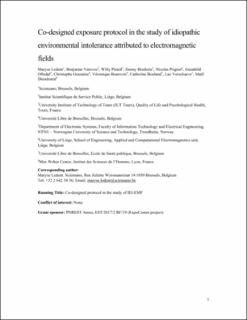| dc.description.abstract | The hypothesis of an electromagnetic origin of idiopathic environmental intolerance (IEI) attributed to electromagnetic fields (EMF) has been widely investigated by provocation studies, which consist of deliberately exposing people with IEI‐EMF in laboratory settings to particular EMF to observe volunteers’ reactions. In the majority of these studies, reactions have been found to be independent of exposure. However, most of these studies suffer from design and methodological limitations that might bias their findings or reduce their precision. As provocation studies are best suited for isolating the effects of EMF, innovative protocols should be applied. In the ExpoComm project (PNREST Anses, EST/2017/2 RF/19), several innovations have been introduced: the involvement of people with IEI‐EMF in the development of the protocol, the attenuation of the anxiogenic nature of the tests, the individualization of the protocol, the validation of the neutral or normal reactivity state before the test, and the use of a cocktail of real, rather than artificially generated, sources. The objective of involving people with IEI‐EMF was to increase the relevance and acceptability of the protocol, while respecting technical constraints and scientific quality requirements. This paper describes the protocol resulting from the collaborative process. Bioelectromagnetics. 2020;41:425–437. © 2020 Bioelectromagnetics Society. | en_US |
